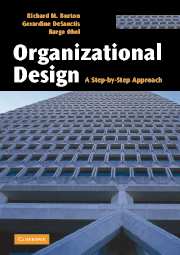Book contents
- Frontmatter
- Contents
- List of figures
- List of tables
- Preface
- An outline of the step-by-step approach
- Step 1 Getting started
- Step 2 Strategy
- Step 3 Structure
- 4 The configuration and complexity of the firm
- 5 Distributed organizations
- Step 4 Process and people
- Step 5 Coordination and Control
- Applying the step-by-step approach in a dynamic world
- References
- Index
4 - The configuration and complexity of the firm
- Frontmatter
- Contents
- List of figures
- List of tables
- Preface
- An outline of the step-by-step approach
- Step 1 Getting started
- Step 2 Strategy
- Step 3 Structure
- 4 The configuration and complexity of the firm
- 5 Distributed organizations
- Step 4 Process and people
- Step 5 Coordination and Control
- Applying the step-by-step approach in a dynamic world
- References
- Index
Summary
Introduction
The choice of a firm's configuration – sometimes called its structure or architecture – is a critical decision for the executive (Burton & Obel, 2004). The next step in the step-by-step approach is for you to choose a configuration and decide on the organizational complexity which will enable your firm to perform well for its given goals and strategy and in its environment. A poor choice of configuration leads to opportunity losses which can be a threat to the organization's short-term efficiency and effectiveness as well as its long-term viability. As in the earlier chapters, for convenience of expression, we use the term “firm” or “organization” as the unit of analysis, but you can substitute team, department or division if that is the unit of analysis you chose in Chapters 1, 2 and 3.
A firm's configuration, frequently pictured as an organizational chart, tells us how the firm partitions big tasks into smaller tasks either by specialization or product, and then also indicates the formal communication patterns. As discussed in Chapter 1, organizational design of configuration involves two complementary problems: (1) how to partition a big task of the whole organization into smaller basic tasks of the subunits, and (2) how to coordinate these smaller subunit tasks so that they fit together to efficiently realize the bigger task or organizational goals (Mintzberg, 1983). Once tasks are partitioned and the smaller subunits specified, the information-processing questions for organizational design are: Who makes what decisions based upon what information?
- Type
- Chapter
- Information
- Organizational DesignA Step-by-Step Approach, pp. 57 - 81Publisher: Cambridge University PressPrint publication year: 2006



